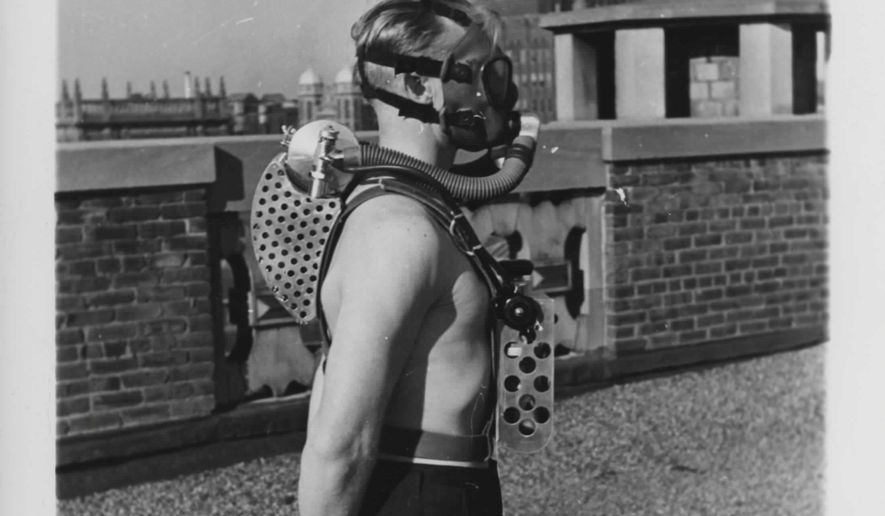They watched for bubbles to surface as the man with a crude scuba mask swam across the basement pool of a prominent Washington hotel 75 years ago this week.
That top-secret World War II-era experiment, seeking to develop the sabotage skills of America’s first elite swimmer-commandos, was the critical opening chapter in the evolving history of the U.S. Navy SEALs.
That afternoon, covert operatives watching Christian Lambertsen’s underwater swim were focused more on whether the air bubbles would break the surface and betray his mission. Nobody saw any.
Last week at the Omni Shoreham Hotel above Rock Creek Park, in the same room that once housed the pool, a crowd gathered to commemorate that fateful event.
They included some prominent former SEALs — Interior Secretary Ryan Zinke, Undersecretary of Defense for Intelligence Joseph Kernan and Rep. Scott Taylor, Virginia Republican — in addition to veterans of the fabled World War II espionage unit and predecessor to the CIA, the Office of Strategic Services (OSS) Society, which sponsored the affair.
Combat historian and best-selling author Patrick K. O’Donnell discussed Lambertsen’s newly revealed story. In his 2015 book, “First SEALs: The Untold Story of the Forging of America’s Most Elite Unit,” Mr. O’Donnell explored what triggered Washington’s scramble for swimmer-commandos and traced it back to an incident in the waters off the coast of Egypt less than two weeks after the Japanese attack on Pearl Harbor.
On the night of Dec. 19, 1941, the British navy suffered a devastating sabotage attack. A tanker and two battleships were sunk in Alexandria Harbor, the home of the British navy’s eastern Mediterranean fleet.
Perplexed British intelligence officers soon determined who did it: Six Italian swim commandos, or “frogmen,” using underwater breathing devices, had covertly infiltrated the harbor. The news rattled the British and U.S. governments.
“As a result of [the Italians’] daring attack, the balance of maritime power in that part of the world shifted, setting off an underwater arms race,” Mr. O’Donnell wrote.
Because America had no special operations units in 1942, officials turned to the OSS to create them.
Launched by the legendary Gen. William Donovan, whose statue now stands outside CIA headquarters, the OSS in its heyday deployed more than 13,000 operatives, a third of them women, in addition to four future CIA directors.
‘Glorious amateurs’
Pioneers of intelligence collection and unconventional warfare, OSS agents were in Gen. Donovan’s words “glorious amateurs” who undertook “some of the bravest acts of the war.” Agents quickly dove into developing underwater combat swim technology for its Maritime Unit, or MU.
Finding that the Navy lacked equipment, the OSS enlisted Mr. Lambertsen. At the time, he was a young civilian medical student at the University of Pennsylvania who had developed what he called an underwater “rebreather” cobbled together from an old World War I gas mask, a bicycle pump and other parts.
Mr. O’Donnell said the early secret tests on the rebreather were dicey. Once, OSS scientists filled an airtight chamber with poisonous gas, a dog, a canary and Mr. Lambertsen.
“First the canary and then the dog fell over, as expected (they were not wearing rebreathers), but when Lambertsen leaned over to check the animals, he fell over too,” Mr. O’Donnell writes. “Fortunately, Lambertsen survived, and development of the device continued.”
Experiments continued at the Shoreham hotel because its basement pool was one of the largest in the city at the time.
Soon, the OSS and Mr. Lambertsen were supervising the manufacture of America’s first rebreather for military use, in addition to wetsuits, swim fins, face masks, motorized surfboards, floating mattresses and even one-man submarines.
The OSS MU then kicked into high gear, recruiting a motley, street-smart, distinguished crew of lifeguards, doctors, Olympic-caliber swimmers and surfers, a roster that included future San Francisco 49ers receiver and kicker Gordon Soltau and Marine Sterling Hayden, who went on to Hollywood fame in Stanley Kubrick’s “Dr. Strangelove” as the paranoid, nuclear-war-starting Gen. Jack D. Ripper and as Capt. McCluskey in “The Godfather.”
The unit conducted some of the war’s most perilous missions across Europe and Asia, conducting sabotage, gathering intelligence, supplying resistance movements, capturing high-value targets and infiltrating enemy coastlines using floating mattresses.
The SEALs, which stands for “sea, air, land,” were formally established by President Kennedy in 1962. Today, they rank as some of the world’s most elite troops partaking some of the riskiest missions.
But the role of the OSS is not forgotten. The Maritime Unit that got its start in a Washington hotel pool began to formulate the capabilities of today’s SEAL teams, according to naval historians.
As for Mr. Lambertsen, he would become known as the “Father of American Combat Swimming” after coining the term “scuba.”
“The OSS Maritime Unit is a case study in innovation and American exceptionalism,” Mr. O’Donnell said. “A small group of men with hardly any funding but a lot of courage took an idea and forged a reality that lives on today.”
In 2016, after years of lobbying by the OSS Society, Congress awarded OSS veterans the Congressional Gold Medal. The society is now fundraising to build a National Museum of Intelligence and Special Operations in Northern Virginia. Charles Pinck, the society’s president, said the museum’s purpose will be to “honor Americans who served at ‘the tip of the spear’ and inspire future generations of Americans to serve their country.”
• Dan Boylan can be reached at dboylan@washingtontimes.com.




Please read our comment policy before commenting.